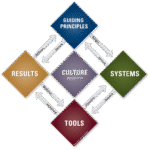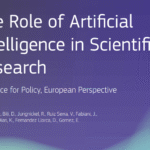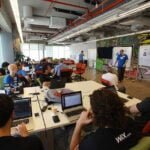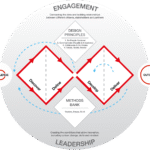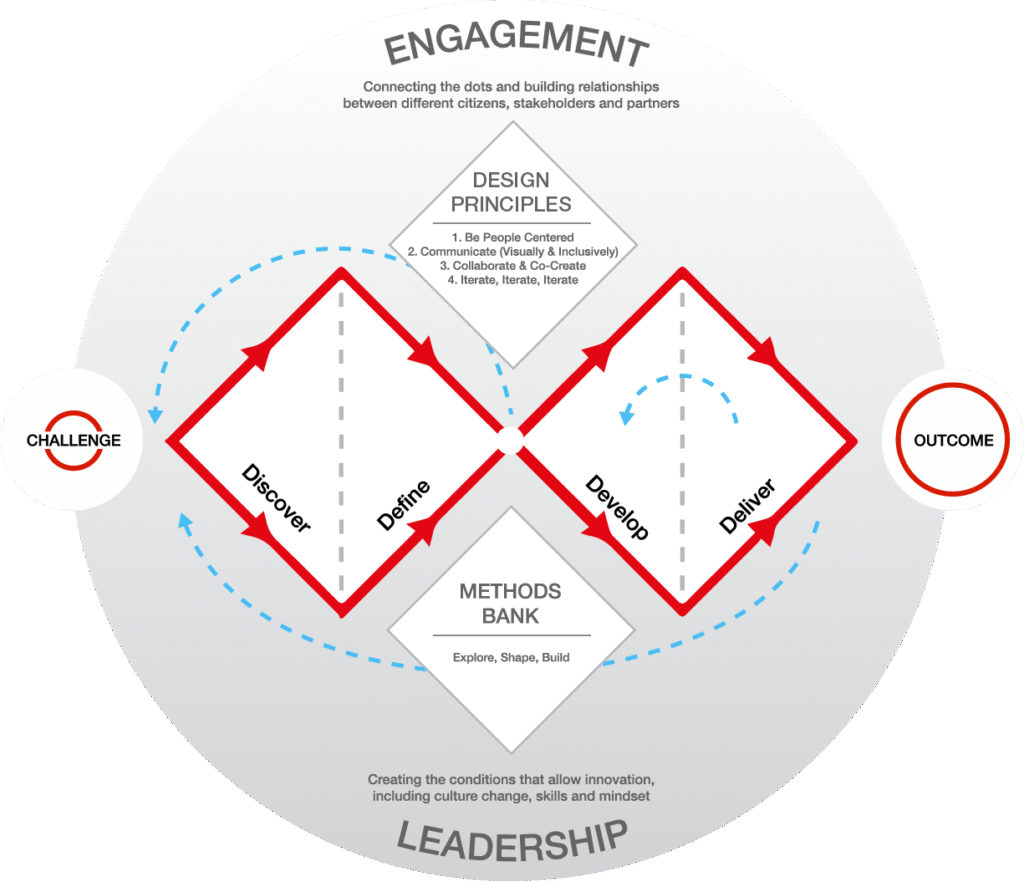
Have you ever been part of a project that, after months of work, delivered an elegant solution to a problem nobody had? Or perhaps a brilliant idea that was technically impossible to build with the available budget? If so, you are not alone. This is one of the greatest fears in product and service development.
This is where the Double Diamond Model comes into play, a design framework acclaimed for its ability to structure the chaos of innovation. It promises to guide us in solving the right problem before jumping into building the right solution.
But is it truly the panacea it seems to be?
While the theory is elegant, its real-world application is filled with nuances, challenges, and often, frustration. In this definitive guide, we will not only break down what the Double Diamond model is and its phases, but we will also dive into the critical gap between the ideal diagram and the harsh reality of projects. We will analyze its problems, the most common criticisms, and, most importantly, provide you with the tools to use it effectively—not as a rigid dogma, but as a flexible map for innovation.
Key takeaways
- The Double Diamond is not just a diagram but a mindset that enforces the discipline of thoroughly exploring and defining the right problem before rushing to develop the right solution. Its goal is to avoid the common mistake of creating products or services that nobody needs.
- Treating the model as a strict, linear process is its biggest pitfall. The success of its application depends on understanding it as a flexible and iterative map. Teams must be prepared to move back and forth between phases as they learn, since innovation is inherently a messy process.
- One of the most severe criticisms of the model is that, when applied in isolation, it can generate fantastic ideas that are technically or financially unfeasible. The conclusion is clear: involving developers and business stakeholders from the very first phase (“Discover”) is not optional; it is a requirement to ensure that solutions are realistic and viable.
- The Double Diamond shines when tackling complex and ill-defined problems (innovation from scratch, service redesign). However, it is a poor choice for incremental improvements, simple problem-solving, or projects with tight technical constraints, where its extensive exploration process would be excessive and inefficient.
- The model is not a rival to Design Thinking or Agile. On the contrary, it functions as a visual process for the Design Thinking philosophy and integrates seamlessly with execution methodologies like Agile/Scrum, especially in its final “Deliver” phase, allowing the solution to be built and validated iteratively.
What is the Double Diamond Model?
The Double Diamond Model is a visual map of the design process. Created in 2004 by the British Design Council, its objective is to help teams tackle complex problems in a structured, human-centered way. It is not a rigid methodology but a framework for thinking that organizes the creative process into four distinct phases.
Origin and Purpose: A Creation of the Design Council
The Design Council studied the creative processes of major companies like LEGO, Sony, and Microsoft to identify common patterns in successful innovation. The result was the Double Diamond, a graphical representation that captures a workflow that expands and contracts twice.
Its fundamental purpose is to avoid two common errors:
- Jumping to solutions without fully understanding the problem.
- Settling for the first viable idea without exploring potentially better alternatives.
The Fundamental Principle: Divergent and Convergent Thinking
The magic of the model lies in the alternation between two types of thinking:
- Divergent Thinking (broadening the focus): This is the exploration phase. It involves investigating widely, generating as many ideas as possible, and considering multiple perspectives without judgment. It is a process of “widening” the view.
- Convergent Thinking (narrowing the focus): This is the decision-making phase. Here, the information or ideas generated in the divergent phase are analyzed, filtered, and synthesized to make clear decisions and move forward. It is a process of “narrowing” the view to a specific point.
The Double Diamond model is structured into two main phases, represented as “diamonds.” The first focuses on the problem, using a process of divergence to explore all its facets and, subsequently, convergence to define it precisely. The second diamond focuses on the solution, diverging again to generate multiple proposals and converging to develop and implement the most suitable one.
This cyclical methodology prevents two of the most common errors in innovation: tackling the wrong problem and adopting the first viable solution without exploring other alternatives.
In this regard, Gustafsson (2019) notes that the main strength of the Double Diamond lies in its fundamental principle: expanding the field of possibilities to discover innovative solutions (divergence) before evaluating and selecting the most promising options (convergence). Similarly, the study by Saad et al. (2020) underscores the importance of combining divergent and convergent thinking to efficiently optimize the resolution of design problems. Finally, Li (2025) describes this model as a robust and widely recognized framework for addressing complex challenges. However, he warns that its effectiveness, especially in designing services for sustainable communities, depends on its adaptation and optimization through the inclusion of key elements like “co-creation” and continuous “feedback.”
The 4 Key Principles That Underpin It
The Design Council updated its model to include four essential principles that should guide the entire process:
- Put People First: Deeply understanding the needs, experiences, and motivations of the people you are designing for is the foundation of everything.
- Collaborate and Co-create: Involving diverse stakeholders (users, developers, business, etc.) from the beginning enriches the process and generates better outcomes.
- Iterate, Iterate, Iterate: The process is not linear. It is about testing ideas, learning from mistakes, and constantly refining solutions.
- Visualize and Make Tangible: Communicating ideas through prototypes, diagrams, and sketches helps everyone understand and contribute more effectively.
The 4 Phases of the Double Diamond: A Step-by-Step Breakdown
The model developed by the Design Council is divided into four clear phases: Discover, Define, Develop, and Deliver. Let’s explore what happens in each one.
Phase 1: Discover (Divergence) – Understanding the Real Problem
The first diamond begins with an exploration phase. The goal here is not to find solutions, but to understand the problem in its entirety from the user’s perspective.
- Objective: To empathize with users, identify their pain points, and unmet needs. It’s about investigating the “what” and the “why” of the initial problem.
- Mindset: Open-minded, curious, without prejudice.
- Common Activities: User interviews, surveys and questionnaires, field observation (ethnography), competitor analysis (benchmarking), creation of User Personas and Empathy Maps, Service Safaris, and User Shadowing.
- Outcome: A large amount of raw data (qualitative and quantitative) that reveals the complexity of the problem.
- Practical Example: A team wants to improve its food delivery app. Instead of adding features, they spend two weeks talking to delivery drivers and customers. They discover that the biggest pain point isn’t the lack of options, but the anxiety caused by not knowing if the order will arrive in time for the family dinner.
- My Advice: In this phase, forbid the word “solution.” The most common mistake I’ve seen is teams starting to devise answers without having formulated the right question. Resist the temptation.
Phase 2: Define (Convergence) – Focusing on the Right Challenge
With all the information gathered, it’s time to converge. This phase is crucial and often the most difficult. It’s about synthesizing the findings to clearly articulate the core problem that will be solved.
- Objective: To transform the data from the discovery phase into a clear, actionable, and user-centered problem statement.
- Mindset: Analytical, critical, and focused.
- Common Activities: Data analysis and clustering (Affinity Mapping), creating User Journeys to identify friction points, defining key insights, formulating the problem statement or design challenge (using techniques like “How Might We…?”).
- Outcome: A well-defined design brief or problem statement that will serve as the North Star for the rest of the project. For example: “How might we help busy professionals plan their weekly meals to be quick, healthy, and affordable?”
- Practical Example: The delivery app team analyzes their findings and defines the key problem: “How might we reduce the anxiety of waiting and give the user a sense of control over their order?” This is much more powerful than “add a better map.”
- My Advice: A good problem statement does not suggest a solution. If your problem definition already includes the answer (“The problem is that we don’t have a live chat”), go back to the Discover phase.
Phase 3: Develop (Divergence) – Exploring Multiple Solutions
Now that the problem is clearly defined, the second diamond begins. We return to a divergent mode, but this time focused on generating potential solutions to the defined problem.
- Objective: To brainstorm a wide variety of possible solutions, from the most obvious to the most innovative. Quantity is more important than quality in this initial stage.
- Mindset: Creative, collaborative, and unafraid of “bad ideas.”
- Common Activities: Brainstorming and Brainwriting sessions, co-creation workshops with stakeholders and users, creating storyboards and sketches, Business Model Canvas, Service Blueprinting, Experience Prototyping, and developing low-fidelity prototypes (wireframes, paper mockups).
- Outcome: A diverse set of initial concepts and prototypes that address the problem from different angles.
- Practical Example: For the “waiting anxiety” problem, the team generates 50 ideas: from a delivery driver Tamagotchi to notifications with a reassuring tone of voice, to an automatic compensation system for delays.
- My Advice: Invite people from other departments (yes, engineers too!) to these sessions. The best ideas often come from combining radically different perspectives.
Phase 4: Deliver (Convergence) – Building and Testing the Final Solution
The final phase consists of converging towards a single viable solution. It’s about testing, refining, and preparing the chosen solution for its launch.
- Objective: To validate solutions with real users, iterate based on feedback, and develop a final product or service that is ready for the market.
- Mindset: Pragmatic, feedback-oriented, and detail-driven.
- Common Activities: Usability testing with high-fidelity prototypes, Design Scenarios, creating a Minimum Viable Product (MVP), final development and quality assurance (QA), launch planning and metrics collection.
- Outcome: The final solution, tested, validated, and delivered to users.
- Practical Example: The team prototypes three of the most promising ideas, tests them with users, and discovers that a simple visual timeline with clear phases (“Order received,” “Cooking,” “Driver en route”) is what best reduces anxiety. They develop that feature, launch it, and measure its impact.
- My Advice: “Deliver” is not the end. It is the beginning of a new learning cycle. The feedback you collect here will be the starting point for your next Double Diamond.
The Critical Gap: From the Ideal Model to Project Reality
So far, everything sounds perfect. However, as many UX and product innovation professionals have discovered, the rigid application of the Double Diamond clashes head-on with reality. This is where we address the criticisms of the Double Diamond model and its most common problems.
The Myth of the Linear Process: Why Iteration is Mandatory
Although the diagram is drawn from left to right, the biggest mistake is to treat it as a linear process. Innovation is inherently messy.
- The Reality: Often, during the “Develop” phase, you realize you have defined the problem incorrectly. This requires returning to the first diamond. Iteration is not an option; it is a necessity. The model should be seen as a cycle, not a straight line. Successful teams jump between phases based on what they learn.
The “Elephant in the Room”: Technical Viability and Budget
This is the fiercest and most justified criticism, as often debated in communities like Reddit. The model, in its pure form, prioritizes desirability (what users want) over viability (what is technically possible) and feasibility (what is profitable for the business).
- The Problem: Many teams spend weeks in the “Discover” and “Develop” phases, generating fantastic ideas that are immediately discarded by engineers for being too complex, expensive, or simply impossible to implement with existing technology. This leads to frustration, wasted time, and a gap between design and development.
The Fatal Mistake: Excluding Developers from the First Diamond
Directly related to the previous point, a common mistake is to think that the first diamond (Discover, Define) is only for designers and researchers, and the second (Develop, Deliver) is for developers.
- The Solution: Technical and business viability must be considered from day one. Involve developers and business stakeholders early in the process. Their perspective in the “Discover” phase can guide research toward feasible areas. Their participation in the “Define” phase ensures that the problem is framed in a way that has realistic solutions. They are not a “filter” at the end; they are strategic collaborators from the beginning.
When (and When NOT) Should You Use the Double Diamond?
It is crucial to understand that the Double Diamond is not a universal methodology; its effectiveness is directly linked to the context of each project.
Gustafsson (2019) explains that the model originated in large corporations with established teams and processes, where it can be applied systematically. However, his study reveals that in smaller environments, such as startups, the model is more useful as a guiding conceptual framework than as a formal, rigid process. Meanwhile, Saad et al. (2020) confirm its applicability in various fields like industrial design, provided it is adapted to the specific needs of the project and the designer.
In conclusion, discerning when not to use the Double Diamond is as important as mastering its application.
Ideal Scenarios for Applying the Model
The framework shines when you are facing:
- Complex and ill-defined problems (“Wicked Problems”): When you are unsure of the real problem and need space for exploration.
- Innovation and new products: When creating something from scratch, where the solution space is wide.
- Improving the service experience: When redesigning a complete service involving multiple touchpoints.
- Fostering a design culture: To teach teams unfamiliar with design to think in a more structured and user-centered way.
Warning Signs: When the Double Diamond is a Poor Choice
Forcing the use of this model in the following scenarios can be counterproductive:
- Incremental and well-defined improvements: If you only need to enhance an existing feature or fix a known bug, such an extensive exploration process is excessive.
- Projects with high technical constraints: When working on an existing platform (like Salesforce, SAP, or a CMS) that severely limits possible solutions, a divergent ideation process will only generate unfeasible ideas.
- High-speed environments with limited resources: A full Double Diamond cycle can be lengthy. If you need results quickly, a Design Sprint may be more suitable.
- Teams with low UX maturity: As some professionals warn, such an abstract model can confuse operational teams that need more concrete guidelines.
Application Examples of the Double Diamond Method
Below are several case studies illustrating the successful application of the Double Diamond model in different sectors:
Web Design and User Experience (UX)
The study by Syach et al. (2025) details how the redesign of the ABC Housing website, using the Double Diamond, resulted in a more functional and attractive digital platform. The methodology was key to aligning the final product with user expectations and the company’s business objectives.
Product Innovation and Development
Gustafsson (2019) documents the use of the model in the STROBO project to design a light with an external battery for mobile photography. This case demonstrates its utility in hardware development for startups. Furthermore, Viviani et al. (2024) used the Double Diamond as a central framework in the design of the “Leonardo” micro-vehicle. The team reinterpreted and expanded the model to manage the project’s complexity, proposing a parallel component development that was fundamental for innovation.
Strategy and Sustainable Management
Pyykkö et al. (2021) concluded that the Double Diamond can provide a clear structure to sustainable supply chain management frameworks. They highlight an important nuance: the model is not a strategy in itself, but a process for creating one, serving as a complementary and organizational tool.
Health and Public Services
During the pandemic, Park and Lee (2021) applied the four phases of the model to analyze and redefine the concept of a “health safety net,” achieving a more precise and applicable understanding in crisis contexts. Likewise, Banbury et al. (2021) used the Double Diamond to guide the co-design of a telehealth program for caregivers of people with dementia, effectively structuring the transition from needs research to the development of a validated solution.
Double Diamond, Design Thinking, or Agile? Clarifying the Methodologies Puzzle
Navigating the different innovation frameworks can be a challenge. Below, we clarify the relationship between three of the most popular concepts:
- Design Thinking: This is the overarching philosophy. It is a mindset focused on understanding and solving the real needs of users.
- Double Diamond: This is the process. It is considered one of the most effective visualizations for structuring and guiding the phases of a Design Thinking project, from problem exploration to solution delivery.
- Agile/Scrum: These are the execution methodologies. They focus on managing the development and delivery of the solution iteratively and incrementally.
How Do They Complement Each Other?
Far from being mutually exclusive, these frameworks are powerful allies. Agile methodologies integrate perfectly into the final phase of the Double Diamond (“Deliver”), allowing for building, measuring, and learning in short, efficient cycles. As a practical example, Liang et al. (2024) combined the Double Diamond with systems thinking, user-centered design (UCD), and agile methods to solve complex challenges in integrating physical and digital games.
Alternatives and Complementary Models to the Double Diamond
Recognizing the model’s limitations allows us to combine it with other frameworks or choose a more suitable alternative.
- Design Sprint: A highly structured, 5-day process to quickly validate ideas with prototypes and user testing. It is a compressed and focused version of the second diamond.
- Lean UX: Focuses on rapid “Build-Measure-Learn” cycles, integrating design continuously into agile development sprints. It prioritizes learning through MVPs over exhaustive initial research.
- The “Triple Diamond”: Some modern adaptations propose a third diamond that focuses on long-term sustainability or post-launch execution and growth, ensuring the solution not only gets delivered but also thrives.
Looking toward the future of innovation, Faour (2024) proposes an interesting theoretical expansion of the Double Diamond, specifically adapted for collaboration between humans and Artificial Intelligence (AI). His model breaks down the traditional framework into twelve distinct sub-phases, which are based on managing uncertainty throughout the project. The goal is to maximize the potential of AI within creative design processes, creating a more effective synergy between human cognition and computational power.
Conclusion: Is the Double Diamond the Tool You Need?
The Double Diamond Model remains one of the most powerful tools for innovation, but only if used correctly. Its greatest value lies not in the diagram, but in the mindset it promotes: the discipline of deeply understanding a problem before rushing to solve it.
The Double Diamond fails when followed as a linear dogma, isolated from technical and business reality. It triumphs when used as a flexible and collaborative map, where developers are partners from the beginning and iteration is the norm.
The next time you face a complex challenge, don’t think of the Double Diamond as a script you must follow to the letter. Think of it as a compass that constantly reminds you: first, open your mind to find the right problem; then, focus on defining it; next, open it again to find the right solution; and finally, concentrate to make it a reality.
Frequently Asked Questions (FAQ) about the Double Diamond Model
Is the Double Diamond only for UX designers?
No. It is a problem-solving framework that can be used by product managers, engineers, business strategists, and any team facing a complex problem. The key is multidisciplinary collaboration.
What are the 4 phases of the Double Diamond?
The four phases are Discover, Define, Develop, and Deliver. The first two focus on understanding and defining the right problem, while the last two focus on devising and building the right solution.
How long does a Double Diamond process take?
There is no fixed duration. It can range from a few weeks for a specific problem to many months for the development of a completely new product. The length depends on the complexity of the problem, resources, and the depth of research and testing.
Can it be combined with agile methodologies like Scrum?
Yes, and it is highly recommended. The first diamond (Discover, Define) can be done to establish a vision and a high-level backlog. Then, the second diamond (Develop, Deliver) can be executed in iterative cycles, aligned with Scrum sprints, to build and test the solution incrementally.
How does the Double Diamond connect with Agile methodologies?
They connect perfectly. The Double Diamond helps define WHAT to build (the right product or feature that solves a real problem), while Agile provides the method for HOW to build it efficiently, iteratively, and adaptively. The “Deliver” phase of the Double Diamond is often managed with Agile sprints.
What do divergent and convergent thinking mean?
Divergent thinking is about exploring many possible options and generating a wide range of ideas without judgment (opening the focus). Convergent thinking is about analyzing, filtering, and selecting the best options from those available to make a decision (closing the focus).
What if my team gets stuck in a divergent phase and can’t converge?
This is a common problem. To solve it, it is useful to set a “time-box” (a fixed time limit) for exploration. Additionally, having a strong facilitator and using prioritization techniques (like dot voting or effort vs. impact matrices) can help the team make decisions and move toward the convergent phase.
When should you not use the Double Diamond?
It is not the most efficient tool for very simple, well-defined problems or for incremental optimization projects where the problem and solution are already known. In those cases, a more direct approach like Agile may be sufficient.
References
Banbury A, Pedell S, Parkinson L, Byrne L. Using the Double Diamond model to co-design a dementia caregivers telehealth peer support program. Journal of Telemedicine and Telecare. 2021;27(10):667-673. doi:10.1177/1357633X211048980
Design Council. (s.f.). Design methods for developing services.
Faour, F. (2024). The Segmented Double Diamond. A theoretical framework for innovation in the era of AI [Tesis de maestría, Mälardalen University].
Gustafsson, D. (2019). Analysing the Double diamond design process through research & implementation [Tesis de maestría, Aalto University]
Li, S. (2025). A Service Design Model for Sustainable Communities Based on Double Diamond Modeling Framework. En B. Majoul et al. (Eds.), Proceedings of the 2025 11th International Conference on Humanities and Social Science Research (ICHSSR 2025), Advances in Social Science, Education and Humanities Research 945 (pp. 885-890)
Liang, R., Chu, S., Lawton, D., & Pan, G. (2024). Human-centered design based on the double diamond model for optimizing hybrid game design. Human Factors in Design, Engineering, and Computing, AHFE Open Access, 1.
Park, B.-M., & Lee, H.-J. (2021). Healthcare Safety Nets during the COVID-19 Pandemic Based on Double Diamond Model: A Concept Analysis. Healthcare, 9(8), 1014. https://doi.org/10.3390/healthcare9081014
Pyykkö, H., Suoheimo, M., & Walter, S. (2021). Approaching Sustainability Transition in Supply Chains as a Wicked Problem: Systematic Literature Review in Light of the Evolved Double Diamond Design Process Model. Processes, 9(12), 2135. https://doi.org/10.3390/pr9122135
Saad, E., Elekyaby, M. S., Ali, E. O., & Hassan, S. F. A. E. (2020). Double diamond strategy saves time of the design process. International Design Journal, 10(3), 211-222.
Syach, I. N., Arifah, I. D. C., & Kroft, K. van der. (2025). Application of the Double Diamond Method in the UI/UX Website Redesign to Improve User Engagement, Experience, and Satisfaction of ABC Housing . Journal of Digital Business and Innovation Management, 4(1).
Viviani, S., Gulino, M.-S., Rinaldi, A., & Vangi, D. (2024). An Interdisciplinary Double-Diamond Design Thinking Model for Urban Transport Product Innovation: A Design Framework for Innovation Combining Mixed Methods for Developing the Electric Microvehicle “Leonardo Project”. Energies, 17(23), 5918. https://doi.org/10.3390/en17235918
Editor and founder of “Innovar o Morir” (‘Innovate or Die’). Milthon holds a Master’s degree in Science and Innovation Management from the Polytechnic University of Valencia, with postgraduate diplomas in Business Innovation (UPV) and Market-Oriented Innovation Management (UPCH-Universitat Leipzig). He has practical experience in innovation management, having led the Fisheries Innovation Unit of the National Program for Innovation in Fisheries and Aquaculture (PNIPA) and worked as a consultant on open innovation diagnostics and technology watch. He firmly believes in the power of innovation and creativity as drivers of change and development.
